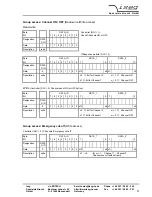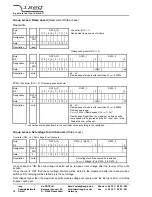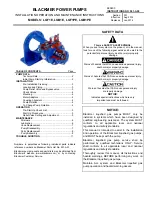
S p e z i a l e l e k t r o n i k G m b H
iseg
c/o ROTECH
Email: [email protected]
Phone ++ 49 351 / 26 95 - 260
Spezialelektronik
Bautzner Landstr. 45
http://www.iseg-hv.com
Fax
++ 49 351 / 26 95 - 261
4
GmbH
D - 01454 Rossendorf
Germany
3. Handling
The supply voltages and the CAN interface is connected to the module via a 96-pin connector on the
rear side of the module.
The 9-channel Module EHQ 9005-F is assembled of two sub-modules (8 channels / 1 channel),
each controlled independently via an own CAN identifier.
The maximum output current for each channel is defined through the position of an internal
potentiometer (I
max
0 to I
max
7 corresponding to channel 1 to 8 and I
max
0 to channel 9).
The output current will be limited to this setting value after it exceeds the threshold and the green
LED on the front panel is ‘OFF‘.
A safety loop will be installed with the help of the upper and lower SL contacts (on the middle
contact bank) from the REDEL-Connector. If the safety loop is active then output voltage is present
only if a current is flowing in a range of 5 to 20 mA of any polarity ( i.e. safety loop is closed). If the
safety loop is opened during operation then the output voltages are shut off without ramp and the
corresponding bit in the ‘Status module’ will be cancelled. After the loop will be closed again the
channels must be switched ‘ON’ and a new set voltage must be given before it is able to offer an
output voltage. The pins of the loop are potential free, the internal voltage drop is ca. 3 V. Coming
from the factory the safety loop is not active (the corresponding bit is always set). Removing of an
internal jumper makes the loop active (s. App. A).
The connector (V-) of each channels should be connected to ground at a certain chosen point.
Otherwise it must be sure, that the potential between (V-) and GND should not exceed the amount
of
15 V
.
The sense line (S-) and (S+) has to be connected to the load without any exception. Otherwise the
output voltage V
O
is ca. 20 V above of the given V
set.
Pin assignment 96-pin connector according to DIN 41612:
PIN
PIN
PIN
Data
a1
b1
c1
+5V
a3
b3
c3
+24V
a5
b5
c5
GND
a11
@CAN_GND
b11
@CANL
potential free
c11
@CANH
a13
RESET
b13
OFF with ramp (e.g. 10s after power fail)
a30
A4
b30
A5
c30
GND
a31
A2
b31
A3
c31
GND
Address field
a32
A0
b32
A1
c32
GND
module address ( A0 ... A5)
The hardware signal “OFF with ramp” (Pulse High-Low-High, pulse width
≤
100 µs) on pin b13 will be
shut off the output voltage for all channels with a ramp analogue to the Group access “Channel
ON/
OFF”
. The ramp speed is defined to V
OUTmax
/ 50 s. This is the actually module ramp speed after
“OFF with ramp”.
With help of the Group access “Channel
ON
/OFF
”
all channels are switched “ON” again.
With the address field a30/b30 ..... a32/b32 the module address will be coded.
(see item 4.4, description 11bit-Identifier).
Connected to GND
⇒
A(n) = 0 ; contact open
⇒
A(n) = 1





































